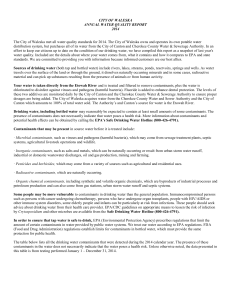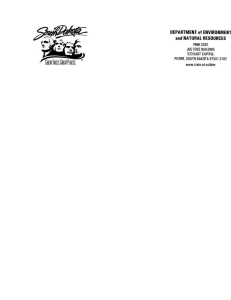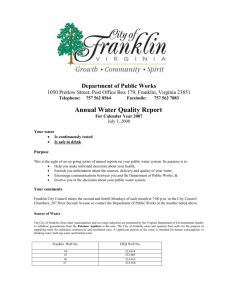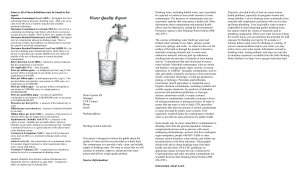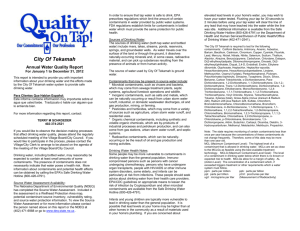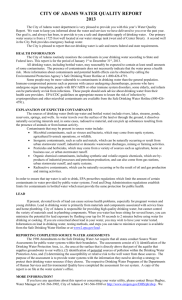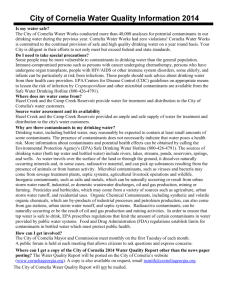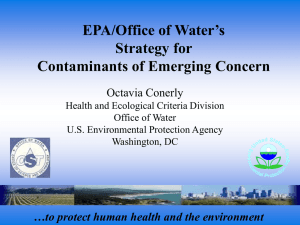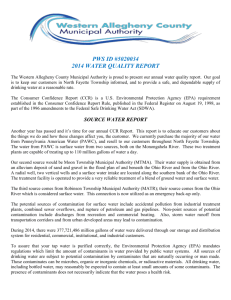click here - Geneseo Hills Homeowners Association
advertisement
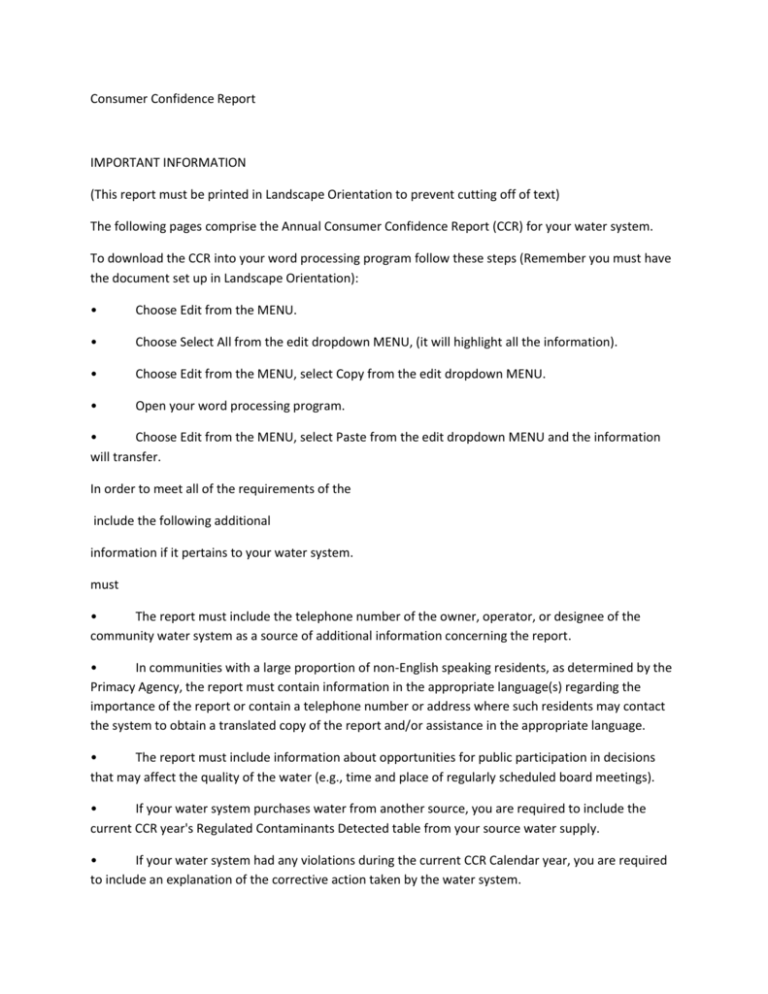
Consumer Confidence Report IMPORTANT INFORMATION (This report must be printed in Landscape Orientation to prevent cutting off of text) The following pages comprise the Annual Consumer Confidence Report (CCR) for your water system. To download the CCR into your word processing program follow these steps (Remember you must have the document set up in Landscape Orientation): • Choose Edit from the MENU. • Choose Select All from the edit dropdown MENU, (it will highlight all the information). • Choose Edit from the MENU, select Copy from the edit dropdown MENU. • Open your word processing program. • Choose Edit from the MENU, select Paste from the edit dropdown MENU and the information will transfer. In order to meet all of the requirements of the include the following additional information if it pertains to your water system. must • The report must include the telephone number of the owner, operator, or designee of the community water system as a source of additional information concerning the report. • In communities with a large proportion of non-English speaking residents, as determined by the Primacy Agency, the report must contain information in the appropriate language(s) regarding the importance of the report or contain a telephone number or address where such residents may contact the system to obtain a translated copy of the report and/or assistance in the appropriate language. • The report must include information about opportunities for public participation in decisions that may affect the quality of the water (e.g., time and place of regularly scheduled board meetings). • If your water system purchases water from another source, you are required to include the current CCR year's Regulated Contaminants Detected table from your source water supply. • If your water system had any violations during the current CCR Calendar year, you are required to include an explanation of the corrective action taken by the water system. • If your water system is going to use the CCR to deliver a Public Notification, you must include the full notice and return a copy of the CCR and Public Notice with the Public Notice This is in addition to the copy and certification form required by the CCR Rule. 04/26/2015 1 10 of IL0735600_2014_2015-04-26_19-00-48.RTF • The information about likely sources of contamination provided in the CCR is generic. Specific information regarding contaminants may be available in sanitary surveys and source water assessments and should be used when available to the operator. • If a community water system distributes water to its customers from multiple hydraulically independent distribution systems fed by different raw water sources, the table should contain a separate column for each service area, and the report should identify each separate distribution system. Alternatively, systems may produce separate reports tailored to include data for each service area. • Detections of unregulated contaminants for which monitoring is required are not included in the CCR and must be added. When added, the information must include the average and range at which the contaminant was detected. • If a water system has performed any monitoring for Cryptosporidium, including monitoring performed to satisfy the requirements of the Information Collection Rule [ICR] (§141.143), which indicates that Cryptosporidium may be present in the source water or the finished water, the report must include: (a) a summary of the results of the monitoring; and (b) an explanation of the significance of the results. • If a water system has performed any monitoring for radon which indicates that radon may be present in the finished water, the report must include: (a) The results of the monitoring; and (b) An explanation of the significance of the results. • If a water system has performed additional monitoring which indicates the presence of other contaminants in the finished water, EPA strongly encourages systems to report any results which may indicate a health concern. To determine if results may indicate a health concern, EPA recommends that systems find out if EPA has proposed an NPDWR or issued a health advisory for that contaminant by calling the Safe Drinking Water Hotline (800–426–4791). EPA considers detects above a proposed MCL or health advisory level to indicate possible health concerns. For such contaminants, EPA recommends that the report include: (a) the results of the monitoring; and (b) an explanation of the significance of the results noting the existence of a health advisory or a proposed regulation. • If you are a ground water system that receives notice from the state of a significant deficiency, you must inform your customers in your CCR report of any significant deficiencies that are not corrected by December 31 of the year covered by it. The CCR must include the following information: - The nature of the significant deficiency and the date it was identified by the state. If the significant deficiency was not corrected by the end of the calendar year, include information regarding the State-approved plan and schedule for correction, including interim measures, progress to date, and any interim measures completed. If the significant deficiency was corrected by the end of the calendar year, include information regarding how the deficiency was corrected and the date it was corrected. 04/26/2015 2 10 of IL0735600_2014_2015-04-26_19-00-48.RTF Source of Drinking Water The sources of drinking water (both tap water and bottled water) include rivers, lakes, streams, ponds, reservoirs, springs, and wells. As water travels over the surface of the land or through the ground, it dissolves naturally-occurring minerals and, in some cases, radioactive material, and can pickup substances resulting from the presence of animals or from human activity. Contaminants that may be present in source water include: - Microbial contaminants, such as viruses and bacteria, which may come from sewage treatment plants, septic systems, agricultural livestock operations, and wildlife. - Inorganic contaminants, such as salts and metals, which can be naturally-occurring or result from urban storm water runoff, industrial or domestic wastewater discharges, oil and gas production, mining, or farming. - Pesticides and herbicides, which may come from a variety of sources such as agriculture, urban storm water runoff, and residential uses. - Organic chemical contaminants, including synthetic and volatile organic chemicals, which are byproducts of industrial processes and petroleum production, and can also come from gas stations, urban storm water runoff, and septic systems. - Radioactive contaminants, which can be naturally-occurring or be the result of oil and gas production and mining activities. Immuno-compromised persons such as persons with cancer undergoing chemotherapy, persons who have undergone organ transplants, people with HIV/AIDS or other immune system disorders, some elderly and infants can be particularly at risk from infections. These people should seek advice about drinking water from their health care providers. EPA/CDC guidelines on appropriate means to lessen the risk of infection by Cryptosporidium and other microbial contaminants are available from the Safe Drinking Water Hotline (800-426-4791). If present, elevated levels of lead can cause serious health problems, especially for pregnant women and young children. Lead in drinking water is primarily from materials and components associated with service lines and home plumbing. We cannot control the variety of materials used in plumbing components. When your water has been sitting for several hours, you can minimize the potential for lead exposure by flushing your tap for 30 seconds to 2 minutes before using water for drinking or cooking. If you are concerned about lead in your water, you may wish to have your water tested. Information on lead in drinking water, testing methods, and steps you can take to minimize exposure is available from the Safe Drinking Water Hotline or at http://www.epa.gov/safewater/lead. GENESEO HILLS SUBDIVISION IL0735600 The source of drinking water used by Drinking water, including bottled water, may reasonably be expected to contain at least small amounts of some contaminants. The presence of contaminants does not necessarily indicate that water poses a health risk. More information about contaminants and potential health effects can be obtained by calling the EPAs Safe Drinking Water Hotline at (800) 426-4791. Annual Water Quality Report for the period of January 1 to December 31, 2014 This report is intended to provide you with important information about your drinking water and the efforts made by the water system to provide safe drinking water. For more information regarding this report contact: Name _______Josh Cackly_______________________ Phone ________(309)441-5042 ___________________ Este informe contiene información muy importante sobre el agua que usted bebe. Tradúzcalo ó hable con alguien que lo entienda bien. Annual Drinking Water Quality Report In order to ensure that tap water is safe to drink, EPA prescribes regulations which limit the amount of certain contaminants in water provided by public water systems. FDA regulations establish limits for contaminants in bottled water which must provide the same protection for public health. Some people may be more vulnerable to contaminants in drinking water than the general population. GENESEO HILLS SUBDIVISION is Ground Water 04/26/2015 3 10 of IL0735600_2014_2015-04-26_19-00-48.RTF 04/26/2015 4 10 of IL0735600_2014_2015-04-26_19-00-48.RTF Source Water Information Source Water Name Report Status Type of Water Location WELL 4 (01221) ________ GW 40 FT SE OF WELL 3 WELL 5 (01705) ________ GW ________________________________________ 04/26/2015 5 10 of IL0735600_2014_2015-04-26_19-00-48.RTF Source Water Assessment We want our valued customers to be informed about their water quality. If you would like to learn more, please feel welcome to attend any of our regularly scheduled meetings. The source water assessment for our supply has been completed by the Illinois EPA. If you would like a copy of this information, please stop by City Hall or call our water operator at ____(309) 235-3122_____. To view a summary version of the completed Source Water Assessments, including: Importance of Source Water; Susceptibility to Contamination Determination; and documentation/recommendation of Source Water Protection Efforts, you may access the Illinois EPA website at http://www.epa.state.il.us/cgibin/wp/swap-fact-sheets.pl. Based on information obtained in a Well Site Survey published in 1992 by the Illinois EPA, there are no potential sources within 1,000 feet of the well.The Illinois EPA has determined that Geneseo Hills Subdivision Community Water Supply's source water is not suspectibile to contamination. This determination is based on a number of criteria including; monitoring conducted at the well; monitoring conducted at the entry point to the distribution system; and available hydrogeologic data on the well.Furthermore, in anticipation of the U.S. EPA's proposed Ground Water Rule, the Illinois EPA has determined that the Geneseo Hills Subdivision Community Water Supply is not vulnerable to viral contamination. This determination is based upon the evaluation of following criteria were evaluated during the Vulnerability Waiver Process: the community's well is properly constructed with sound integrity and proper siting conditions; a hydraulic barrier exists which should prevent pathogen movement; all potential routes and sanitary defects have been mitigated such that the source water is adequately protected; monitoring data did not indicate a history of disease outbreak; and the sanitary survey of the water supply did not indicate a viral contamination threat. Because the community's well is constructed in a confined aquifer, which should prevent the movement of pathogens into the well, well hydraulics were not considered to be a significant factor in the susceptibility determination. Hence, well hydraulics were not evaluated for this system ground water supply. 04/26/2015 6 10 of IL0735600_2014_2015-04-26_19-00-48.RTF Lead and Copper Definitions: Action Level Goal (ALG): The level of a contaminant in drinking water below which there is no known or expected risk to health. ALGs allow for a margin of safety. Action Level: The concentration of a contaminant which, if exceeded, triggers treatment or other requirements which a water system must follow. Lead and Copper Date Sampled MCLG Action Level (AL) 90th Percentile # Sites Over AL Units Violation Likely Source of Contamination Copper 2014 1.3 1.3 0.76 0 ppm N Erosion of natural deposits; Leaching from wood preservatives; Corrosion of household plumbing systems. Lead 2014 0 15 2.9 0 ppb N Corrosion of household plumbing systems; Erosion of natural deposits. Water Quality Test Results Maximum Contaminant Level Goal or MCLG: The level of a contaminant in drinking water below which there is no known or expected risk to health. MCLGs allow for a margin of safety. Maximum Contaminant Level or MCL: The highest level of a contaminant that is allowed in drinking water. MCLs are set as close to the MCLGs as feasible using the best available treatment technology. Maximum residual disinfectant level goal or MRDLG: The level of a drinking water disinfectant below which there is no known or expected risk to health. MRDLGs do not reflect the benefits of the use of disinfectants to control microbial contaminants. Maximum residual disinfectant level or MRDL: The highest level of a disinfectant allowed in drinking water. There is convincing evidence that addition of a disinfectant is necessary for control of microbial contaminants. Definitions: The following tables contain scientific terms and measures, some of which may require explanation. ppb: micrograms per liter or parts per billion - or one ounce in 7,350,000 gallons of water. na: not applicable. Avg: Regulatory compliance with some MCLs are based on running annual average of monthly samples. ppm: milligrams per liter or parts per million - or one ounce in 7,350 gallons of water. Regulated Contaminants Detected 2014 04/26/2015 7 10 of IL0735600_2014_2015-04-26_19-00-48.RTF 04/26/2015 8 10 of IL0735600_2014_2015-04-26_19-00-48.RTF Regulated Contaminants Disinfectants and Disinfection By-Products Collection Date Highest Level Detected Range of Levels Detected MCLG MCL Units Violation Likely Source of Contamination Chlorine 12/31/2014 1.4 0.85 - 1.68 MRDLG = 4 MRDL = 4 ppm N Water additive used to control microbes. Total Trihalomethanes (TTHM) 2014 2 1.674 - 1.674 No goal for the total 80 ppb N By-product of drinking water disinfection. Inorganic Contaminants Collection Date Highest Level Detected Range of Levels Detected MCLG MCL Units Violation Likely Source of Contamination Barium 04/03/2012 0.16 0.16 - 0.16 2 2 ppm N Discharge of drilling wastes; Discharge from metal refineries; Erosion of natural deposits. Fluoride 04/03/2012 0.345 0.345 - 0.345 4 4.0 ppm N Erosion of natural deposits; Water additive which promotes strong teeth; Discharge from fertilizer and aluminum factories. Iron 04/03/2012 0.07 0.07 - 0.07 1.0 ppm N This contaminant is not currently regulated by the USEPA. However, the state regulates. Erosion of natural deposits. Manganese 04/03/2012 5.6 5.6 - 5.6 150 150 ppb N This contaminant is not currently regulated by the USEPA. However, the state regulates. Erosion of natural deposits. Sodium 04/03/2012 14 14 - 14 ppm N Erosion from naturally occuring deposits: Used in water softener regeneration. Zinc 04/03/2012 0.015 0.015 - 0.015 5 5 ppm N This contaminant is not currently regulated by the USEPA. However, the state regulates. Naturally occurring; discharge from metal Radioactive Contaminants Collection Date Highest Level Detected Range of Levels Detected MCLG MCL Units Violation Likely Source of Contamination 04/26/2015 9 10 of IL0735600_2014_2015-04-26_19-00-48.RTF Combined Radium 226/228 2014 1.9 1.9 - 1.9 0 5 pCi/L N Erosion of natural deposits. Gross alpha excluding radon and uranium 2014 3.36 3.36 - 3.36 0 15 pCi/L N Erosion of natural deposits. 04/26/2015 10 10 of IL0735600_2014_2015-04-26_19-00-48.RTF
